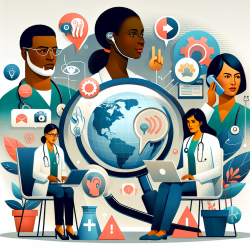Introduction
In the ever-evolving field of speech-language pathology, practitioners are constantly seeking innovative methods to enhance therapeutic outcomes. The recent research on the integration of drones in emergency cardiac care provides a fascinating perspective that can be adapted to our field. This blog explores how the insights from this research can be applied to improve the efficiency and effectiveness of speech-language therapy services, particularly in remote or underserved areas.
Understanding the Research
The study titled "Challenges & barriers for real-time integration of drones in emergency cardiac care: Lessons from the United States, Sweden, & Canada" highlights the potential of drones to deliver Automated External Defibrillators (AEDs) rapidly, thereby increasing survival rates in out-of-hospital cardiac arrest (OHCA) cases. The research underscores the importance of timely intervention, a principle that is equally critical in speech-language pathology.
Applying Drone Insights to Speech-Language Pathology
While the primary focus of the study is on emergency cardiac care, the underlying principles of using technology to bridge gaps in service delivery can be translated into the realm of speech-language pathology. Here are some ways this can be achieved:
- Remote Access to Services: Just as drones can deliver AEDs to remote locations, teletherapy can provide access to speech-language services in areas lacking specialists. This ensures that children in rural or underserved regions receive timely and effective intervention.
- Data-Driven Decisions: The research emphasizes the importance of data in optimizing drone delivery routes. Similarly, speech-language pathologists can utilize data analytics to tailor therapy plans, monitor progress, and adjust interventions based on individual needs.
- Interdisciplinary Collaboration: The integration of drones involved collaboration across various fields. In speech-language pathology, working with educators, healthcare providers, and families can enhance the overall effectiveness of therapy.
Encouraging Further Research
The findings from the drone research encourage speech-language pathologists to explore innovative technologies that can improve therapy outcomes. Practitioners are urged to engage in research that investigates new tools and methods, such as virtual reality or AI-driven assessments, to enhance the therapeutic process.
Conclusion
By drawing parallels between the integration of drones in emergency care and the potential for technological advancements in speech-language pathology, practitioners can adopt a forward-thinking approach to service delivery. This not only improves access and outcomes for children but also positions speech-language pathologists at the forefront of innovation in healthcare.
To read the original research paper, please follow this link: Challenges & barriers for real-time integration of drones in emergency cardiac care: Lessons from the United States, Sweden, & Canada.










